GSK Marketing Strategy Report: Brexit, Pricing, and Strategy Analysis
VerifiedAdded on 2019/09/23
|17
|4528
|62
Report
AI Summary
This report provides a comprehensive analysis of GlaxoSmithKline's (GSK) marketing strategies. It begins with an overview of the company and its evolution from transactional to relationship marketing, highlighting GSK's use of relationship marketing techniques and market orientation policies. The report then evaluates the potential impact of the UK's decision to leave the EU (Brexit) on GSK's marketing strategy, considering the situation in the UK after Brexit, its impact on GSK, and the company's reactions. Furthermore, it identifies and analyzes GSK's current pricing policy, comparing it with competitors, and evaluates its success, suggesting potential improvements. The report concludes with a summary of key findings and recommendations, offering valuable insights into GSK's marketing approach and strategic responses to market changes.
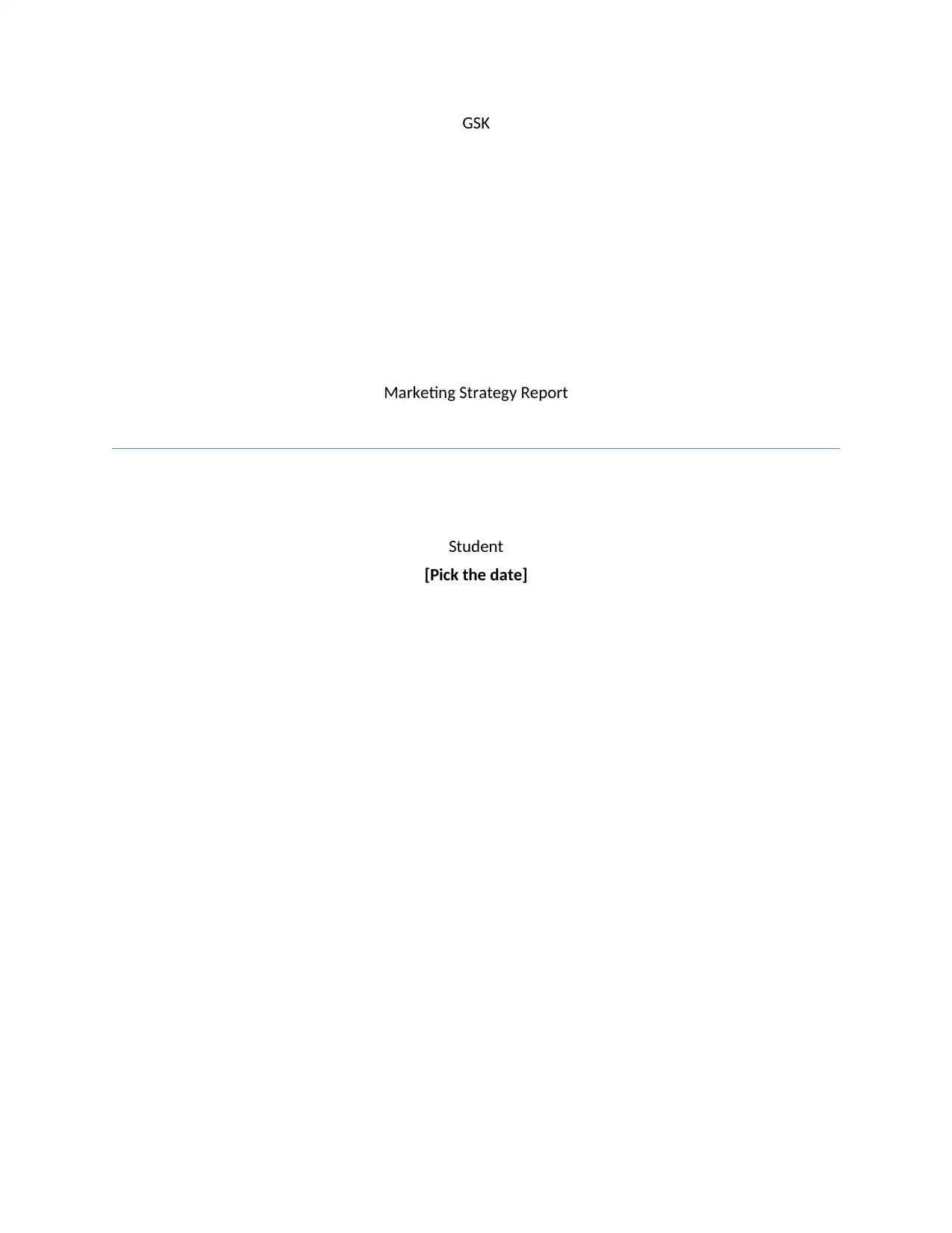
GSK
Marketing Strategy Report
Student
[Pick the date]
Marketing Strategy Report
Student
[Pick the date]
Paraphrase This Document
Need a fresh take? Get an instant paraphrase of this document with our AI Paraphraser
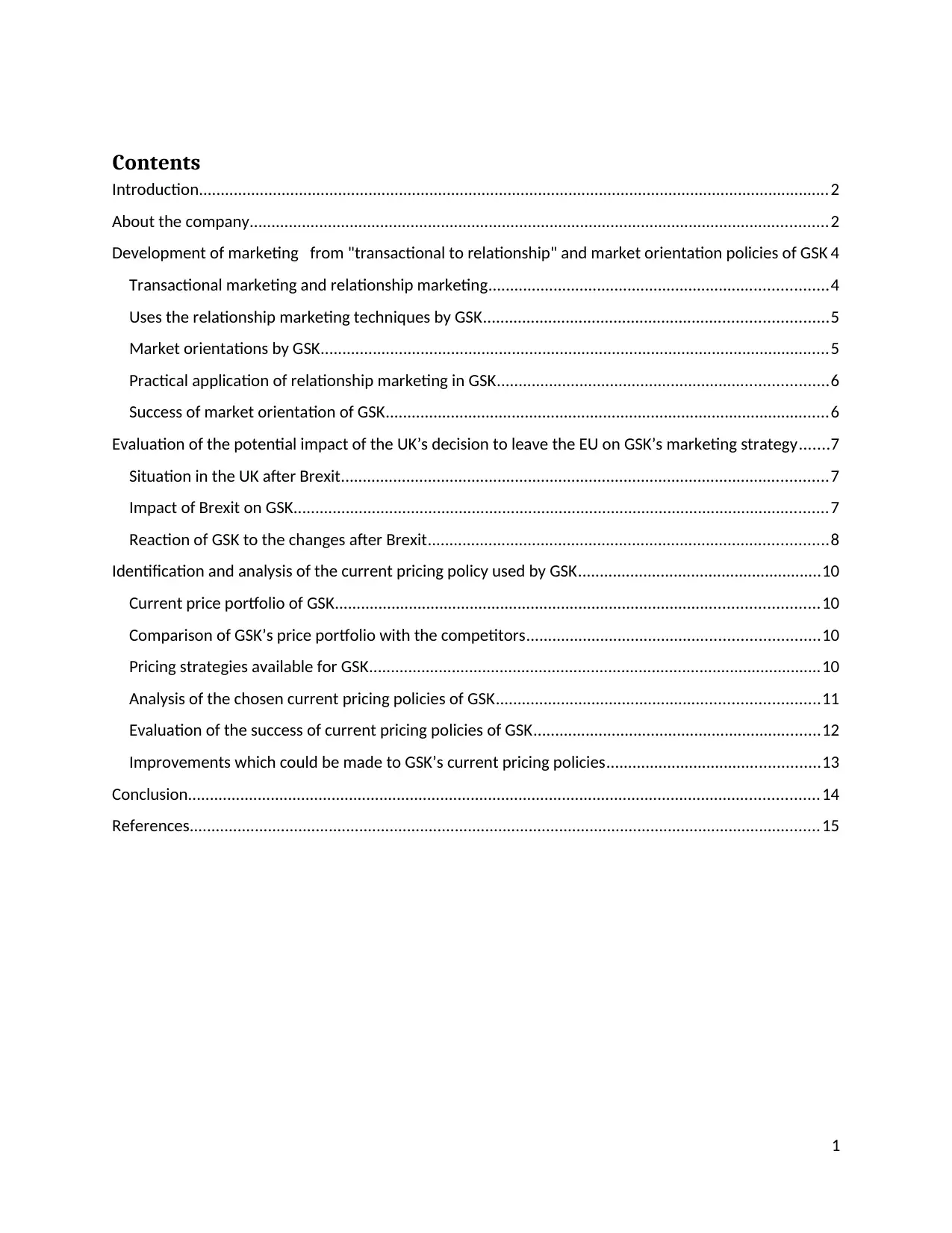
Contents
Introduction.................................................................................................................................................2
About the company.....................................................................................................................................2
Development of marketing from "transactional to relationship" and market orientation policies of GSK 4
Transactional marketing and relationship marketing..............................................................................4
Uses the relationship marketing techniques by GSK...............................................................................5
Market orientations by GSK.....................................................................................................................5
Practical application of relationship marketing in GSK............................................................................6
Success of market orientation of GSK......................................................................................................6
Evaluation of the potential impact of the UK’s decision to leave the EU on GSK’s marketing strategy.......7
Situation in the UK after Brexit................................................................................................................7
Impact of Brexit on GSK...........................................................................................................................7
Reaction of GSK to the changes after Brexit............................................................................................8
Identification and analysis of the current pricing policy used by GSK........................................................10
Current price portfolio of GSK...............................................................................................................10
Comparison of GSK’s price portfolio with the competitors...................................................................10
Pricing strategies available for GSK........................................................................................................10
Analysis of the chosen current pricing policies of GSK..........................................................................11
Evaluation of the success of current pricing policies of GSK..................................................................12
Improvements which could be made to GSK’s current pricing policies.................................................13
Conclusion.................................................................................................................................................14
References.................................................................................................................................................15
1
Introduction.................................................................................................................................................2
About the company.....................................................................................................................................2
Development of marketing from "transactional to relationship" and market orientation policies of GSK 4
Transactional marketing and relationship marketing..............................................................................4
Uses the relationship marketing techniques by GSK...............................................................................5
Market orientations by GSK.....................................................................................................................5
Practical application of relationship marketing in GSK............................................................................6
Success of market orientation of GSK......................................................................................................6
Evaluation of the potential impact of the UK’s decision to leave the EU on GSK’s marketing strategy.......7
Situation in the UK after Brexit................................................................................................................7
Impact of Brexit on GSK...........................................................................................................................7
Reaction of GSK to the changes after Brexit............................................................................................8
Identification and analysis of the current pricing policy used by GSK........................................................10
Current price portfolio of GSK...............................................................................................................10
Comparison of GSK’s price portfolio with the competitors...................................................................10
Pricing strategies available for GSK........................................................................................................10
Analysis of the chosen current pricing policies of GSK..........................................................................11
Evaluation of the success of current pricing policies of GSK..................................................................12
Improvements which could be made to GSK’s current pricing policies.................................................13
Conclusion.................................................................................................................................................14
References.................................................................................................................................................15
1
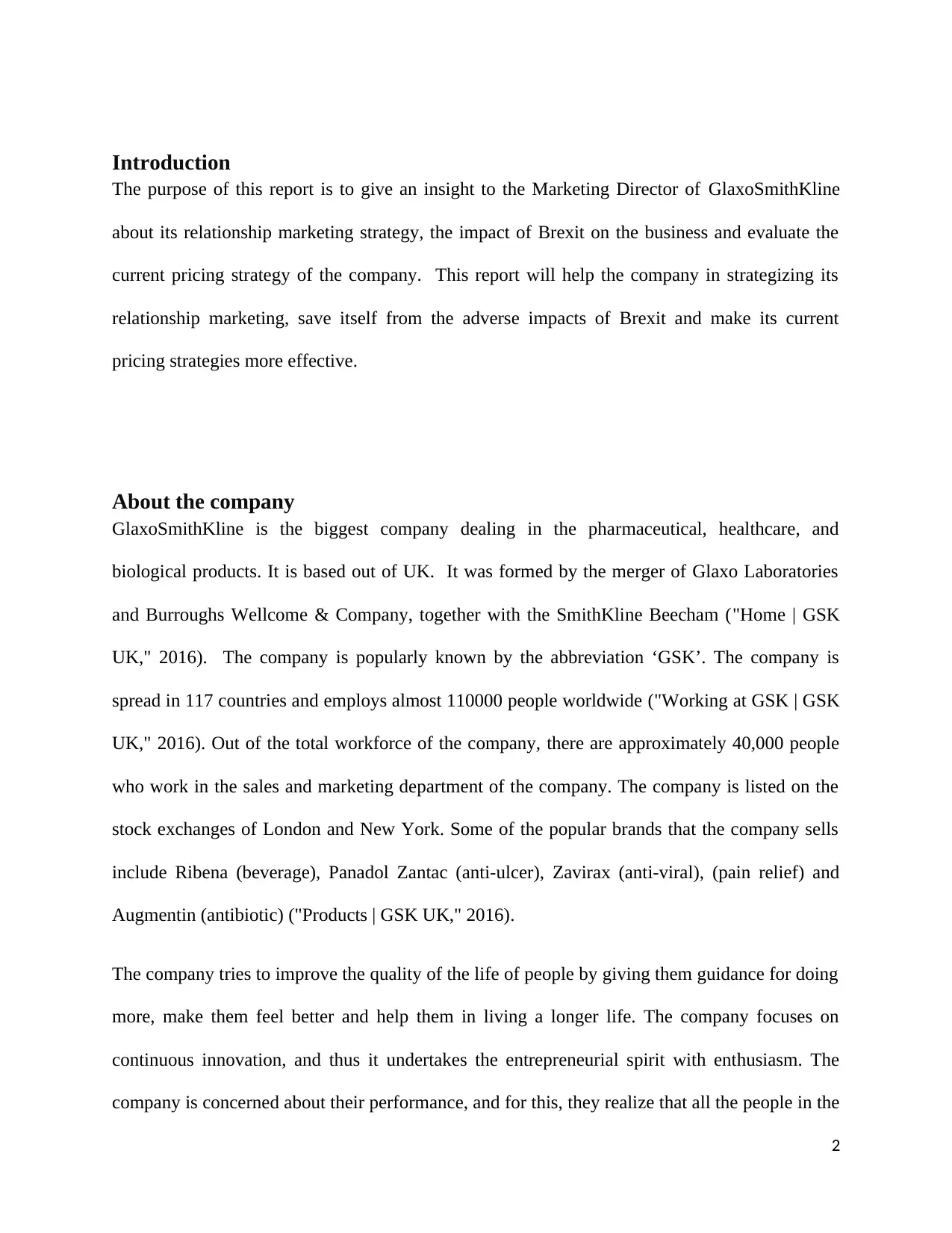
Introduction
The purpose of this report is to give an insight to the Marketing Director of GlaxoSmithKline
about its relationship marketing strategy, the impact of Brexit on the business and evaluate the
current pricing strategy of the company. This report will help the company in strategizing its
relationship marketing, save itself from the adverse impacts of Brexit and make its current
pricing strategies more effective.
About the company
GlaxoSmithKline is the biggest company dealing in the pharmaceutical, healthcare, and
biological products. It is based out of UK. It was formed by the merger of Glaxo Laboratories
and Burroughs Wellcome & Company, together with the SmithKline Beecham ("Home | GSK
UK," 2016). The company is popularly known by the abbreviation ‘GSK’. The company is
spread in 117 countries and employs almost 110000 people worldwide ("Working at GSK | GSK
UK," 2016). Out of the total workforce of the company, there are approximately 40,000 people
who work in the sales and marketing department of the company. The company is listed on the
stock exchanges of London and New York. Some of the popular brands that the company sells
include Ribena (beverage), Panadol Zantac (anti-ulcer), Zavirax (anti-viral), (pain relief) and
Augmentin (antibiotic) ("Products | GSK UK," 2016).
The company tries to improve the quality of the life of people by giving them guidance for doing
more, make them feel better and help them in living a longer life. The company focuses on
continuous innovation, and thus it undertakes the entrepreneurial spirit with enthusiasm. The
company is concerned about their performance, and for this, they realize that all the people in the
2
The purpose of this report is to give an insight to the Marketing Director of GlaxoSmithKline
about its relationship marketing strategy, the impact of Brexit on the business and evaluate the
current pricing strategy of the company. This report will help the company in strategizing its
relationship marketing, save itself from the adverse impacts of Brexit and make its current
pricing strategies more effective.
About the company
GlaxoSmithKline is the biggest company dealing in the pharmaceutical, healthcare, and
biological products. It is based out of UK. It was formed by the merger of Glaxo Laboratories
and Burroughs Wellcome & Company, together with the SmithKline Beecham ("Home | GSK
UK," 2016). The company is popularly known by the abbreviation ‘GSK’. The company is
spread in 117 countries and employs almost 110000 people worldwide ("Working at GSK | GSK
UK," 2016). Out of the total workforce of the company, there are approximately 40,000 people
who work in the sales and marketing department of the company. The company is listed on the
stock exchanges of London and New York. Some of the popular brands that the company sells
include Ribena (beverage), Panadol Zantac (anti-ulcer), Zavirax (anti-viral), (pain relief) and
Augmentin (antibiotic) ("Products | GSK UK," 2016).
The company tries to improve the quality of the life of people by giving them guidance for doing
more, make them feel better and help them in living a longer life. The company focuses on
continuous innovation, and thus it undertakes the entrepreneurial spirit with enthusiasm. The
company is concerned about their performance, and for this, they realize that all the people in the
2
⊘ This is a preview!⊘
Do you want full access?
Subscribe today to unlock all pages.

Trusted by 1+ million students worldwide
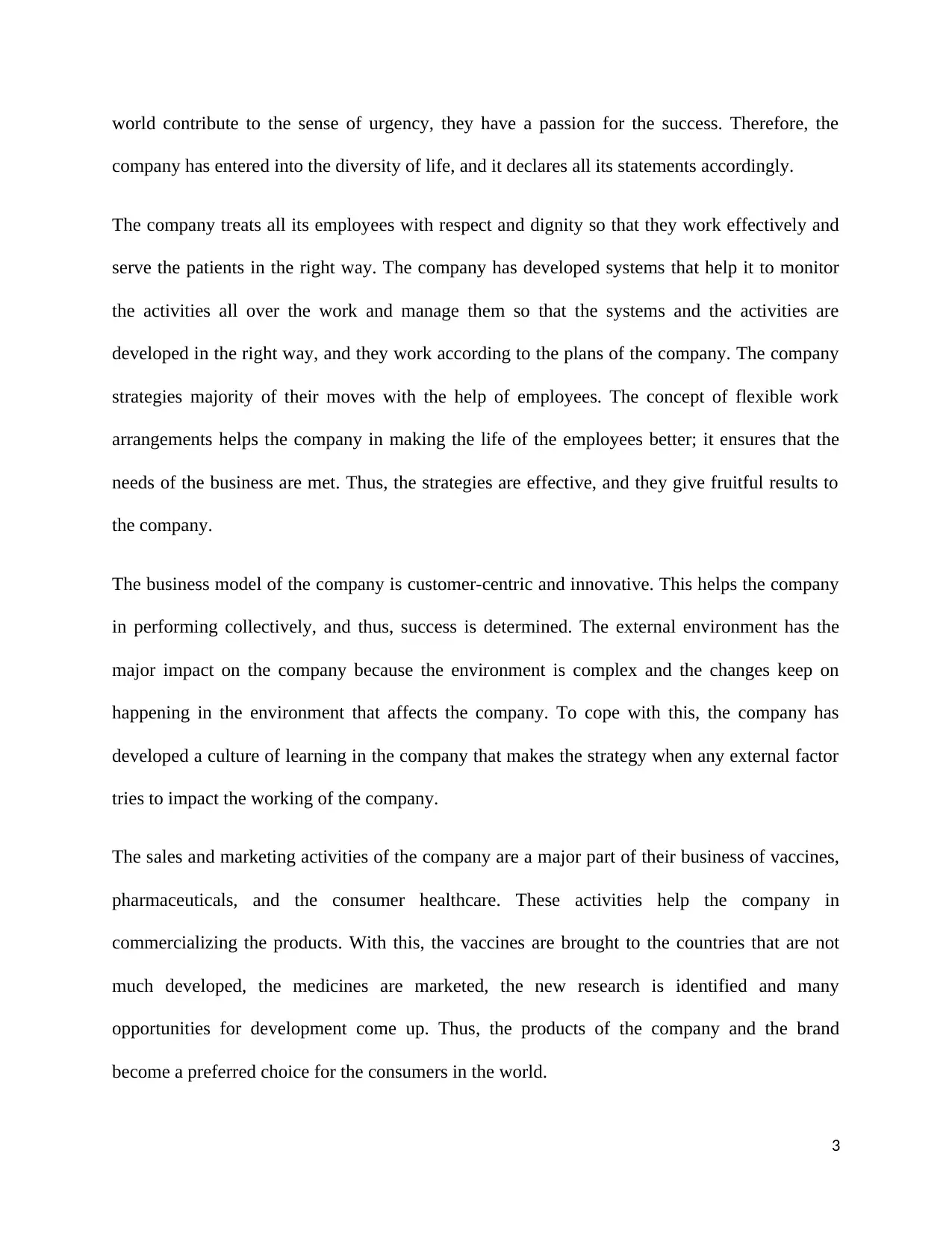
world contribute to the sense of urgency, they have a passion for the success. Therefore, the
company has entered into the diversity of life, and it declares all its statements accordingly.
The company treats all its employees with respect and dignity so that they work effectively and
serve the patients in the right way. The company has developed systems that help it to monitor
the activities all over the work and manage them so that the systems and the activities are
developed in the right way, and they work according to the plans of the company. The company
strategies majority of their moves with the help of employees. The concept of flexible work
arrangements helps the company in making the life of the employees better; it ensures that the
needs of the business are met. Thus, the strategies are effective, and they give fruitful results to
the company.
The business model of the company is customer-centric and innovative. This helps the company
in performing collectively, and thus, success is determined. The external environment has the
major impact on the company because the environment is complex and the changes keep on
happening in the environment that affects the company. To cope with this, the company has
developed a culture of learning in the company that makes the strategy when any external factor
tries to impact the working of the company.
The sales and marketing activities of the company are a major part of their business of vaccines,
pharmaceuticals, and the consumer healthcare. These activities help the company in
commercializing the products. With this, the vaccines are brought to the countries that are not
much developed, the medicines are marketed, the new research is identified and many
opportunities for development come up. Thus, the products of the company and the brand
become a preferred choice for the consumers in the world.
3
company has entered into the diversity of life, and it declares all its statements accordingly.
The company treats all its employees with respect and dignity so that they work effectively and
serve the patients in the right way. The company has developed systems that help it to monitor
the activities all over the work and manage them so that the systems and the activities are
developed in the right way, and they work according to the plans of the company. The company
strategies majority of their moves with the help of employees. The concept of flexible work
arrangements helps the company in making the life of the employees better; it ensures that the
needs of the business are met. Thus, the strategies are effective, and they give fruitful results to
the company.
The business model of the company is customer-centric and innovative. This helps the company
in performing collectively, and thus, success is determined. The external environment has the
major impact on the company because the environment is complex and the changes keep on
happening in the environment that affects the company. To cope with this, the company has
developed a culture of learning in the company that makes the strategy when any external factor
tries to impact the working of the company.
The sales and marketing activities of the company are a major part of their business of vaccines,
pharmaceuticals, and the consumer healthcare. These activities help the company in
commercializing the products. With this, the vaccines are brought to the countries that are not
much developed, the medicines are marketed, the new research is identified and many
opportunities for development come up. Thus, the products of the company and the brand
become a preferred choice for the consumers in the world.
3
Paraphrase This Document
Need a fresh take? Get an instant paraphrase of this document with our AI Paraphraser
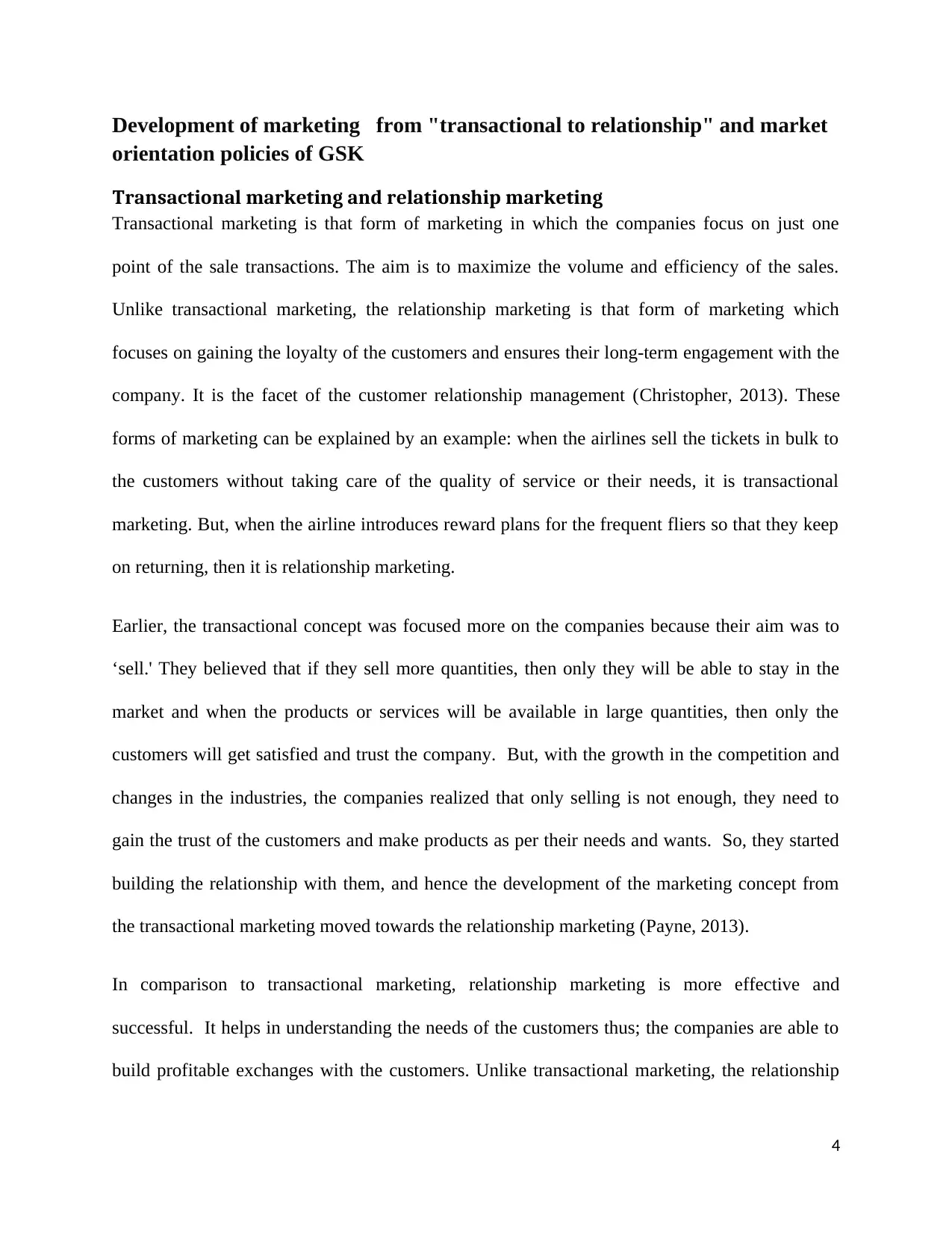
Development of marketing from "transactional to relationship" and market
orientation policies of GSK
Transactional marketing and relationship marketing
Transactional marketing is that form of marketing in which the companies focus on just one
point of the sale transactions. The aim is to maximize the volume and efficiency of the sales.
Unlike transactional marketing, the relationship marketing is that form of marketing which
focuses on gaining the loyalty of the customers and ensures their long-term engagement with the
company. It is the facet of the customer relationship management (Christopher, 2013). These
forms of marketing can be explained by an example: when the airlines sell the tickets in bulk to
the customers without taking care of the quality of service or their needs, it is transactional
marketing. But, when the airline introduces reward plans for the frequent fliers so that they keep
on returning, then it is relationship marketing.
Earlier, the transactional concept was focused more on the companies because their aim was to
‘sell.' They believed that if they sell more quantities, then only they will be able to stay in the
market and when the products or services will be available in large quantities, then only the
customers will get satisfied and trust the company. But, with the growth in the competition and
changes in the industries, the companies realized that only selling is not enough, they need to
gain the trust of the customers and make products as per their needs and wants. So, they started
building the relationship with them, and hence the development of the marketing concept from
the transactional marketing moved towards the relationship marketing (Payne, 2013).
In comparison to transactional marketing, relationship marketing is more effective and
successful. It helps in understanding the needs of the customers thus; the companies are able to
build profitable exchanges with the customers. Unlike transactional marketing, the relationship
4
orientation policies of GSK
Transactional marketing and relationship marketing
Transactional marketing is that form of marketing in which the companies focus on just one
point of the sale transactions. The aim is to maximize the volume and efficiency of the sales.
Unlike transactional marketing, the relationship marketing is that form of marketing which
focuses on gaining the loyalty of the customers and ensures their long-term engagement with the
company. It is the facet of the customer relationship management (Christopher, 2013). These
forms of marketing can be explained by an example: when the airlines sell the tickets in bulk to
the customers without taking care of the quality of service or their needs, it is transactional
marketing. But, when the airline introduces reward plans for the frequent fliers so that they keep
on returning, then it is relationship marketing.
Earlier, the transactional concept was focused more on the companies because their aim was to
‘sell.' They believed that if they sell more quantities, then only they will be able to stay in the
market and when the products or services will be available in large quantities, then only the
customers will get satisfied and trust the company. But, with the growth in the competition and
changes in the industries, the companies realized that only selling is not enough, they need to
gain the trust of the customers and make products as per their needs and wants. So, they started
building the relationship with them, and hence the development of the marketing concept from
the transactional marketing moved towards the relationship marketing (Payne, 2013).
In comparison to transactional marketing, relationship marketing is more effective and
successful. It helps in understanding the needs of the customers thus; the companies are able to
build profitable exchanges with the customers. Unlike transactional marketing, the relationship
4
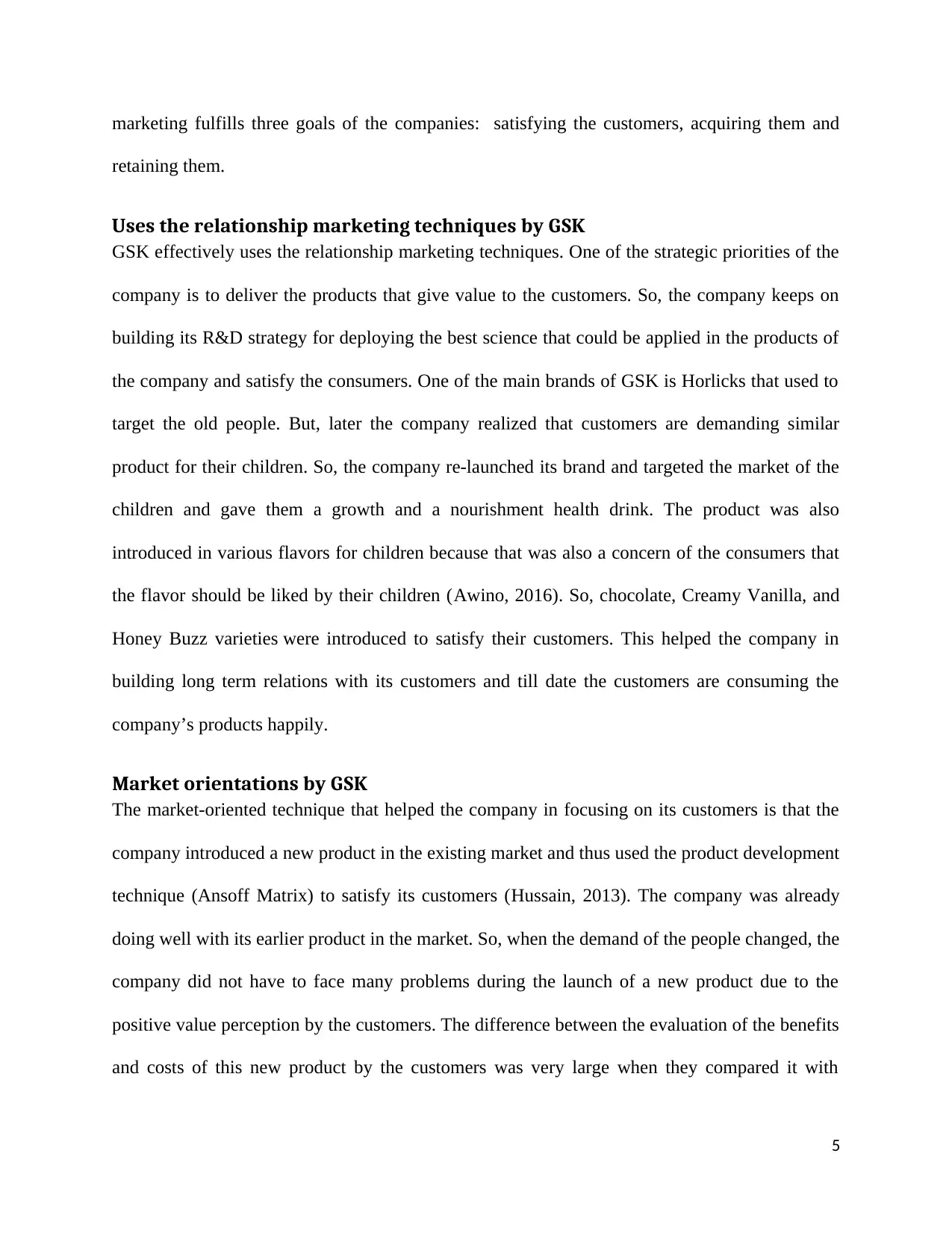
marketing fulfills three goals of the companies: satisfying the customers, acquiring them and
retaining them.
Uses the relationship marketing techniques by GSK
GSK effectively uses the relationship marketing techniques. One of the strategic priorities of the
company is to deliver the products that give value to the customers. So, the company keeps on
building its R&D strategy for deploying the best science that could be applied in the products of
the company and satisfy the consumers. One of the main brands of GSK is Horlicks that used to
target the old people. But, later the company realized that customers are demanding similar
product for their children. So, the company re-launched its brand and targeted the market of the
children and gave them a growth and a nourishment health drink. The product was also
introduced in various flavors for children because that was also a concern of the consumers that
the flavor should be liked by their children (Awino, 2016). So, chocolate, Creamy Vanilla, and
Honey Buzz varieties were introduced to satisfy their customers. This helped the company in
building long term relations with its customers and till date the customers are consuming the
company’s products happily.
Market orientations by GSK
The market-oriented technique that helped the company in focusing on its customers is that the
company introduced a new product in the existing market and thus used the product development
technique (Ansoff Matrix) to satisfy its customers (Hussain, 2013). The company was already
doing well with its earlier product in the market. So, when the demand of the people changed, the
company did not have to face many problems during the launch of a new product due to the
positive value perception by the customers. The difference between the evaluation of the benefits
and costs of this new product by the customers was very large when they compared it with
5
retaining them.
Uses the relationship marketing techniques by GSK
GSK effectively uses the relationship marketing techniques. One of the strategic priorities of the
company is to deliver the products that give value to the customers. So, the company keeps on
building its R&D strategy for deploying the best science that could be applied in the products of
the company and satisfy the consumers. One of the main brands of GSK is Horlicks that used to
target the old people. But, later the company realized that customers are demanding similar
product for their children. So, the company re-launched its brand and targeted the market of the
children and gave them a growth and a nourishment health drink. The product was also
introduced in various flavors for children because that was also a concern of the consumers that
the flavor should be liked by their children (Awino, 2016). So, chocolate, Creamy Vanilla, and
Honey Buzz varieties were introduced to satisfy their customers. This helped the company in
building long term relations with its customers and till date the customers are consuming the
company’s products happily.
Market orientations by GSK
The market-oriented technique that helped the company in focusing on its customers is that the
company introduced a new product in the existing market and thus used the product development
technique (Ansoff Matrix) to satisfy its customers (Hussain, 2013). The company was already
doing well with its earlier product in the market. So, when the demand of the people changed, the
company did not have to face many problems during the launch of a new product due to the
positive value perception by the customers. The difference between the evaluation of the benefits
and costs of this new product by the customers was very large when they compared it with
5
⊘ This is a preview!⊘
Do you want full access?
Subscribe today to unlock all pages.

Trusted by 1+ million students worldwide
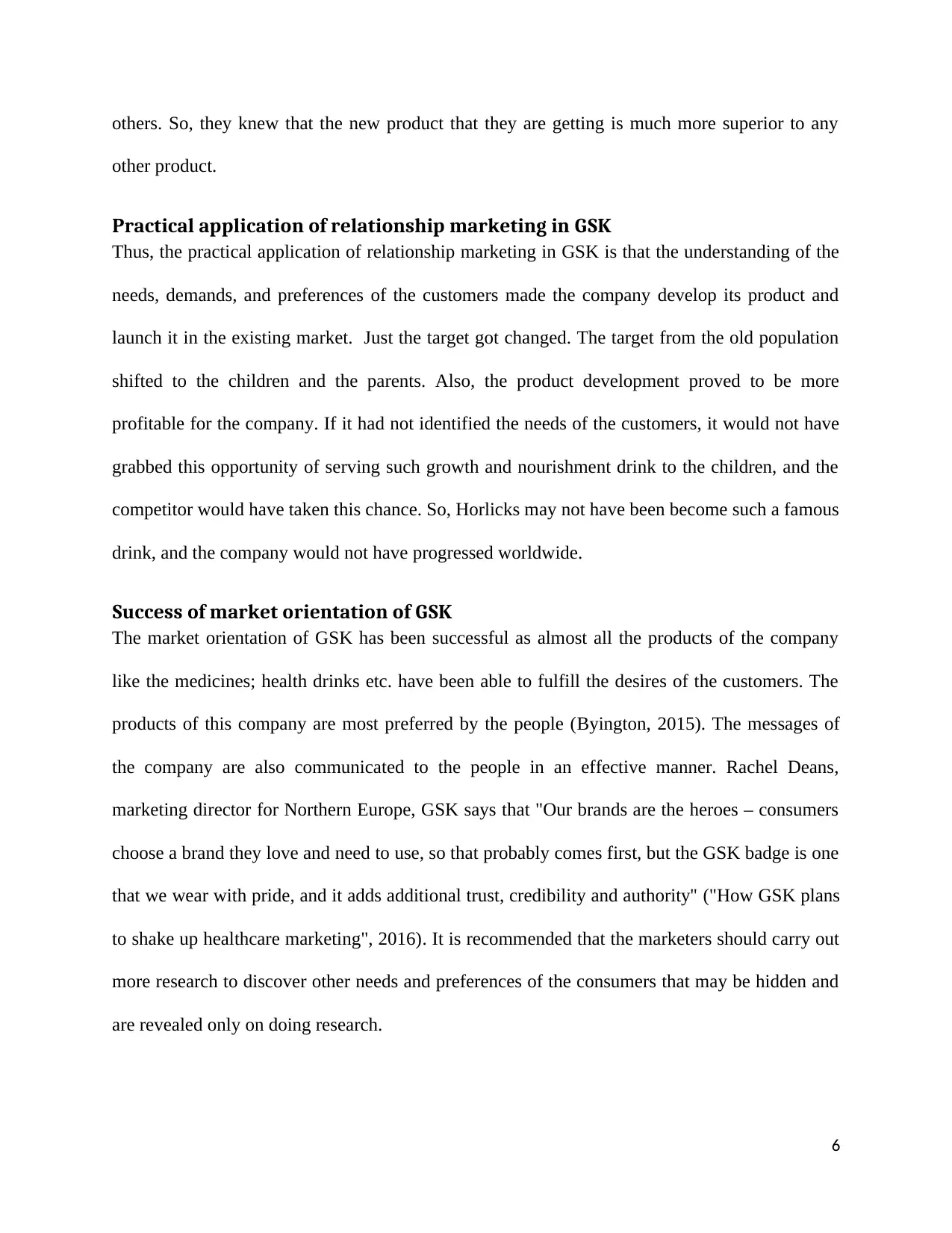
others. So, they knew that the new product that they are getting is much more superior to any
other product.
Practical application of relationship marketing in GSK
Thus, the practical application of relationship marketing in GSK is that the understanding of the
needs, demands, and preferences of the customers made the company develop its product and
launch it in the existing market. Just the target got changed. The target from the old population
shifted to the children and the parents. Also, the product development proved to be more
profitable for the company. If it had not identified the needs of the customers, it would not have
grabbed this opportunity of serving such growth and nourishment drink to the children, and the
competitor would have taken this chance. So, Horlicks may not have been become such a famous
drink, and the company would not have progressed worldwide.
Success of market orientation of GSK
The market orientation of GSK has been successful as almost all the products of the company
like the medicines; health drinks etc. have been able to fulfill the desires of the customers. The
products of this company are most preferred by the people (Byington, 2015). The messages of
the company are also communicated to the people in an effective manner. Rachel Deans,
marketing director for Northern Europe, GSK says that "Our brands are the heroes – consumers
choose a brand they love and need to use, so that probably comes first, but the GSK badge is one
that we wear with pride, and it adds additional trust, credibility and authority'' ("How GSK plans
to shake up healthcare marketing", 2016). It is recommended that the marketers should carry out
more research to discover other needs and preferences of the consumers that may be hidden and
are revealed only on doing research.
6
other product.
Practical application of relationship marketing in GSK
Thus, the practical application of relationship marketing in GSK is that the understanding of the
needs, demands, and preferences of the customers made the company develop its product and
launch it in the existing market. Just the target got changed. The target from the old population
shifted to the children and the parents. Also, the product development proved to be more
profitable for the company. If it had not identified the needs of the customers, it would not have
grabbed this opportunity of serving such growth and nourishment drink to the children, and the
competitor would have taken this chance. So, Horlicks may not have been become such a famous
drink, and the company would not have progressed worldwide.
Success of market orientation of GSK
The market orientation of GSK has been successful as almost all the products of the company
like the medicines; health drinks etc. have been able to fulfill the desires of the customers. The
products of this company are most preferred by the people (Byington, 2015). The messages of
the company are also communicated to the people in an effective manner. Rachel Deans,
marketing director for Northern Europe, GSK says that "Our brands are the heroes – consumers
choose a brand they love and need to use, so that probably comes first, but the GSK badge is one
that we wear with pride, and it adds additional trust, credibility and authority'' ("How GSK plans
to shake up healthcare marketing", 2016). It is recommended that the marketers should carry out
more research to discover other needs and preferences of the consumers that may be hidden and
are revealed only on doing research.
6
Paraphrase This Document
Need a fresh take? Get an instant paraphrase of this document with our AI Paraphraser
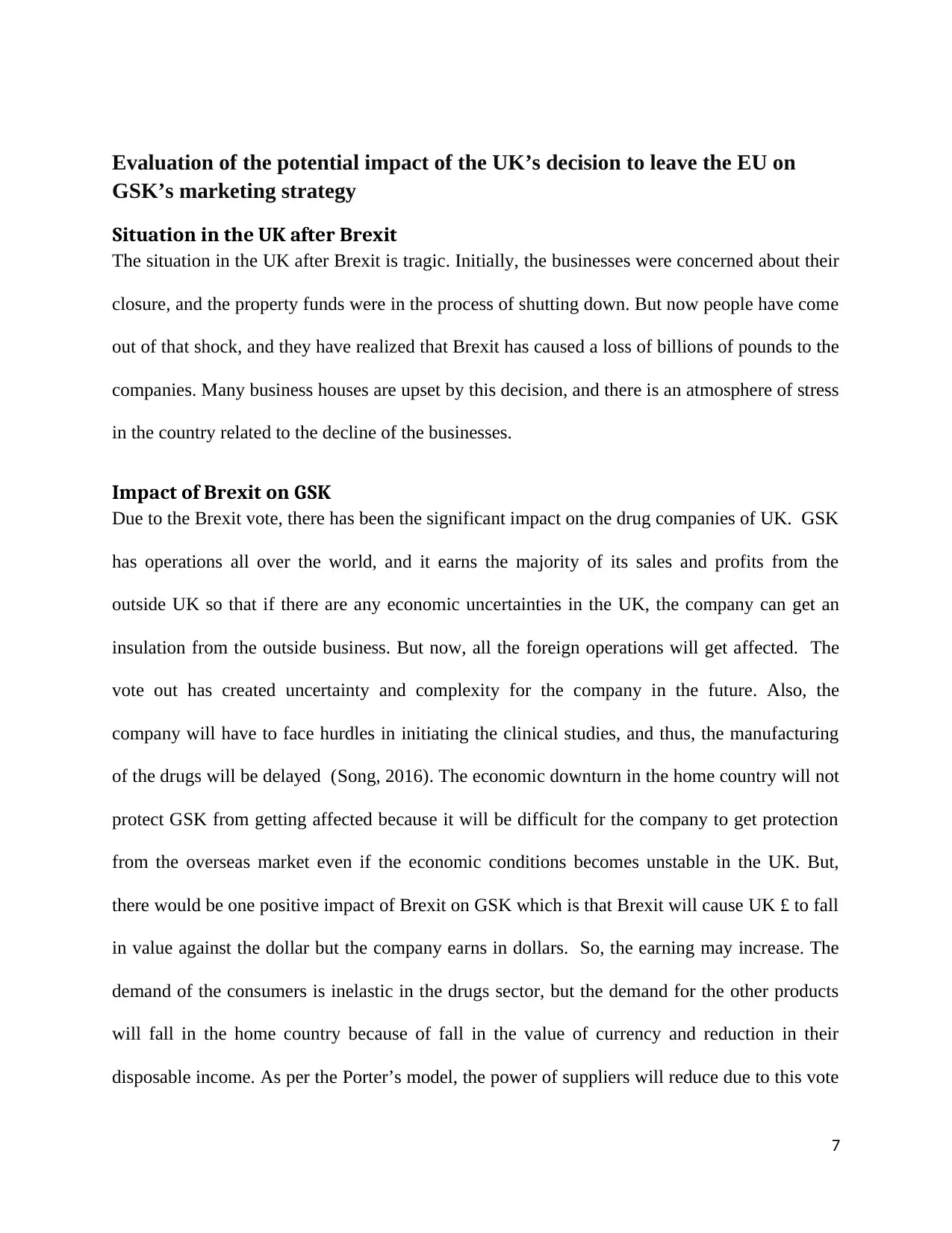
Evaluation of the potential impact of the UK’s decision to leave the EU on
GSK’s marketing strategy
Situation in the UK after Brexit
The situation in the UK after Brexit is tragic. Initially, the businesses were concerned about their
closure, and the property funds were in the process of shutting down. But now people have come
out of that shock, and they have realized that Brexit has caused a loss of billions of pounds to the
companies. Many business houses are upset by this decision, and there is an atmosphere of stress
in the country related to the decline of the businesses.
Impact of Brexit on GSK
Due to the Brexit vote, there has been the significant impact on the drug companies of UK. GSK
has operations all over the world, and it earns the majority of its sales and profits from the
outside UK so that if there are any economic uncertainties in the UK, the company can get an
insulation from the outside business. But now, all the foreign operations will get affected. The
vote out has created uncertainty and complexity for the company in the future. Also, the
company will have to face hurdles in initiating the clinical studies, and thus, the manufacturing
of the drugs will be delayed (Song, 2016). The economic downturn in the home country will not
protect GSK from getting affected because it will be difficult for the company to get protection
from the overseas market even if the economic conditions becomes unstable in the UK. But,
there would be one positive impact of Brexit on GSK which is that Brexit will cause UK £ to fall
in value against the dollar but the company earns in dollars. So, the earning may increase. The
demand of the consumers is inelastic in the drugs sector, but the demand for the other products
will fall in the home country because of fall in the value of currency and reduction in their
disposable income. As per the Porter’s model, the power of suppliers will reduce due to this vote
7
GSK’s marketing strategy
Situation in the UK after Brexit
The situation in the UK after Brexit is tragic. Initially, the businesses were concerned about their
closure, and the property funds were in the process of shutting down. But now people have come
out of that shock, and they have realized that Brexit has caused a loss of billions of pounds to the
companies. Many business houses are upset by this decision, and there is an atmosphere of stress
in the country related to the decline of the businesses.
Impact of Brexit on GSK
Due to the Brexit vote, there has been the significant impact on the drug companies of UK. GSK
has operations all over the world, and it earns the majority of its sales and profits from the
outside UK so that if there are any economic uncertainties in the UK, the company can get an
insulation from the outside business. But now, all the foreign operations will get affected. The
vote out has created uncertainty and complexity for the company in the future. Also, the
company will have to face hurdles in initiating the clinical studies, and thus, the manufacturing
of the drugs will be delayed (Song, 2016). The economic downturn in the home country will not
protect GSK from getting affected because it will be difficult for the company to get protection
from the overseas market even if the economic conditions becomes unstable in the UK. But,
there would be one positive impact of Brexit on GSK which is that Brexit will cause UK £ to fall
in value against the dollar but the company earns in dollars. So, the earning may increase. The
demand of the consumers is inelastic in the drugs sector, but the demand for the other products
will fall in the home country because of fall in the value of currency and reduction in their
disposable income. As per the Porter’s model, the power of suppliers will reduce due to this vote
7
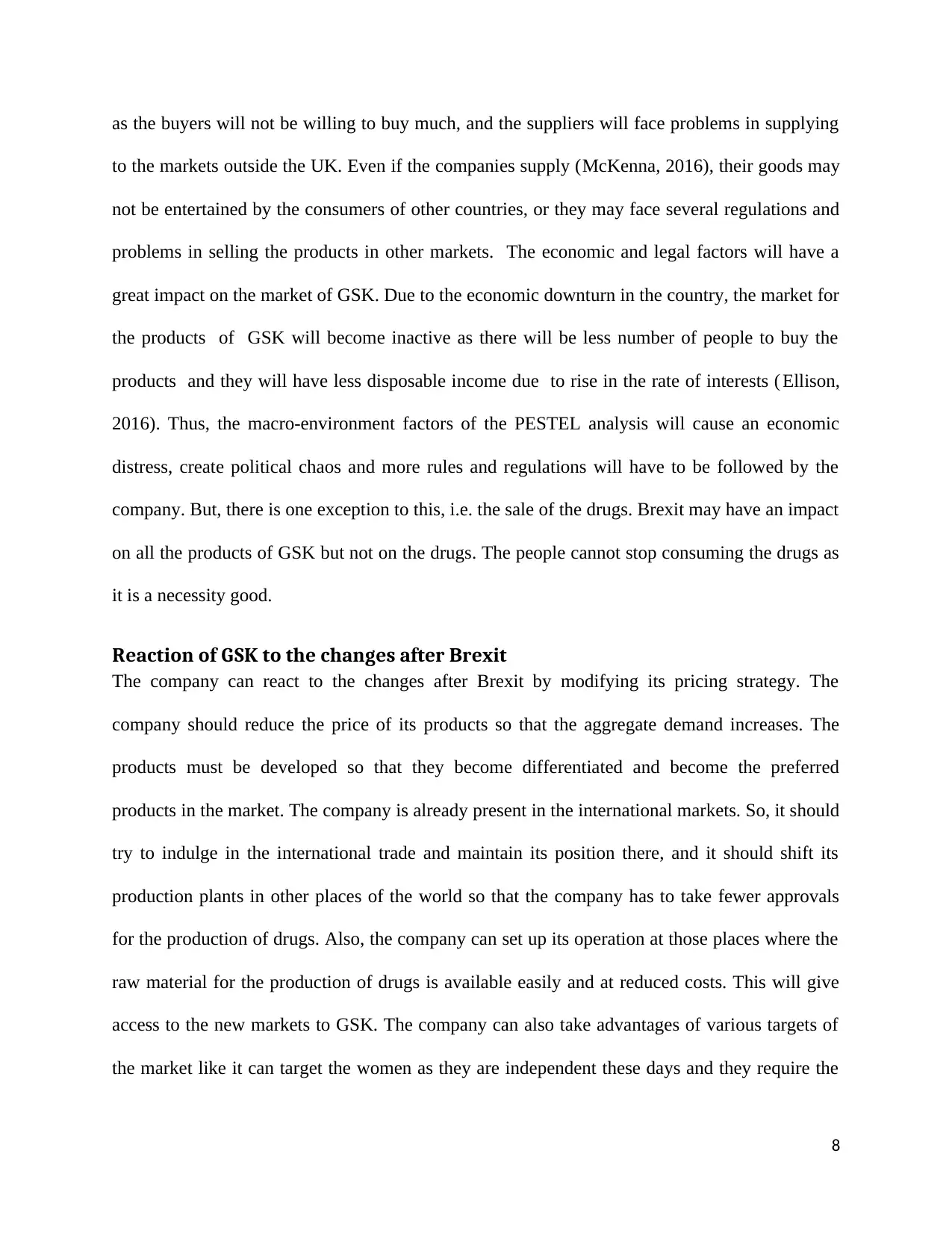
as the buyers will not be willing to buy much, and the suppliers will face problems in supplying
to the markets outside the UK. Even if the companies supply (McKenna, 2016), their goods may
not be entertained by the consumers of other countries, or they may face several regulations and
problems in selling the products in other markets. The economic and legal factors will have a
great impact on the market of GSK. Due to the economic downturn in the country, the market for
the products of GSK will become inactive as there will be less number of people to buy the
products and they will have less disposable income due to rise in the rate of interests ( Ellison,
2016). Thus, the macro-environment factors of the PESTEL analysis will cause an economic
distress, create political chaos and more rules and regulations will have to be followed by the
company. But, there is one exception to this, i.e. the sale of the drugs. Brexit may have an impact
on all the products of GSK but not on the drugs. The people cannot stop consuming the drugs as
it is a necessity good.
Reaction of GSK to the changes after Brexit
The company can react to the changes after Brexit by modifying its pricing strategy. The
company should reduce the price of its products so that the aggregate demand increases. The
products must be developed so that they become differentiated and become the preferred
products in the market. The company is already present in the international markets. So, it should
try to indulge in the international trade and maintain its position there, and it should shift its
production plants in other places of the world so that the company has to take fewer approvals
for the production of drugs. Also, the company can set up its operation at those places where the
raw material for the production of drugs is available easily and at reduced costs. This will give
access to the new markets to GSK. The company can also take advantages of various targets of
the market like it can target the women as they are independent these days and they require the
8
to the markets outside the UK. Even if the companies supply (McKenna, 2016), their goods may
not be entertained by the consumers of other countries, or they may face several regulations and
problems in selling the products in other markets. The economic and legal factors will have a
great impact on the market of GSK. Due to the economic downturn in the country, the market for
the products of GSK will become inactive as there will be less number of people to buy the
products and they will have less disposable income due to rise in the rate of interests ( Ellison,
2016). Thus, the macro-environment factors of the PESTEL analysis will cause an economic
distress, create political chaos and more rules and regulations will have to be followed by the
company. But, there is one exception to this, i.e. the sale of the drugs. Brexit may have an impact
on all the products of GSK but not on the drugs. The people cannot stop consuming the drugs as
it is a necessity good.
Reaction of GSK to the changes after Brexit
The company can react to the changes after Brexit by modifying its pricing strategy. The
company should reduce the price of its products so that the aggregate demand increases. The
products must be developed so that they become differentiated and become the preferred
products in the market. The company is already present in the international markets. So, it should
try to indulge in the international trade and maintain its position there, and it should shift its
production plants in other places of the world so that the company has to take fewer approvals
for the production of drugs. Also, the company can set up its operation at those places where the
raw material for the production of drugs is available easily and at reduced costs. This will give
access to the new markets to GSK. The company can also take advantages of various targets of
the market like it can target the women as they are independent these days and they require the
8
⊘ This is a preview!⊘
Do you want full access?
Subscribe today to unlock all pages.

Trusted by 1+ million students worldwide
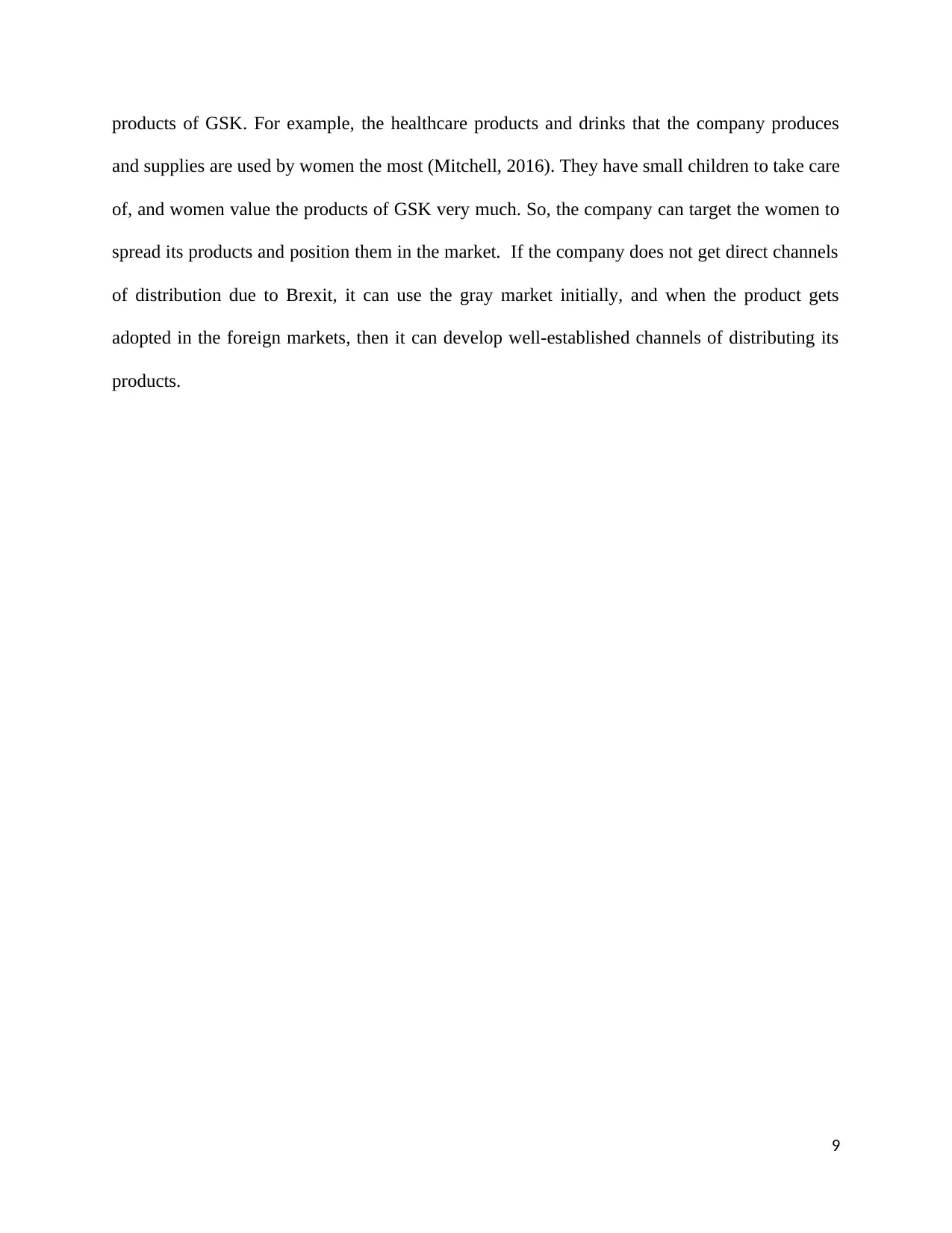
products of GSK. For example, the healthcare products and drinks that the company produces
and supplies are used by women the most (Mitchell, 2016). They have small children to take care
of, and women value the products of GSK very much. So, the company can target the women to
spread its products and position them in the market. If the company does not get direct channels
of distribution due to Brexit, it can use the gray market initially, and when the product gets
adopted in the foreign markets, then it can develop well-established channels of distributing its
products.
9
and supplies are used by women the most (Mitchell, 2016). They have small children to take care
of, and women value the products of GSK very much. So, the company can target the women to
spread its products and position them in the market. If the company does not get direct channels
of distribution due to Brexit, it can use the gray market initially, and when the product gets
adopted in the foreign markets, then it can develop well-established channels of distributing its
products.
9
Paraphrase This Document
Need a fresh take? Get an instant paraphrase of this document with our AI Paraphraser
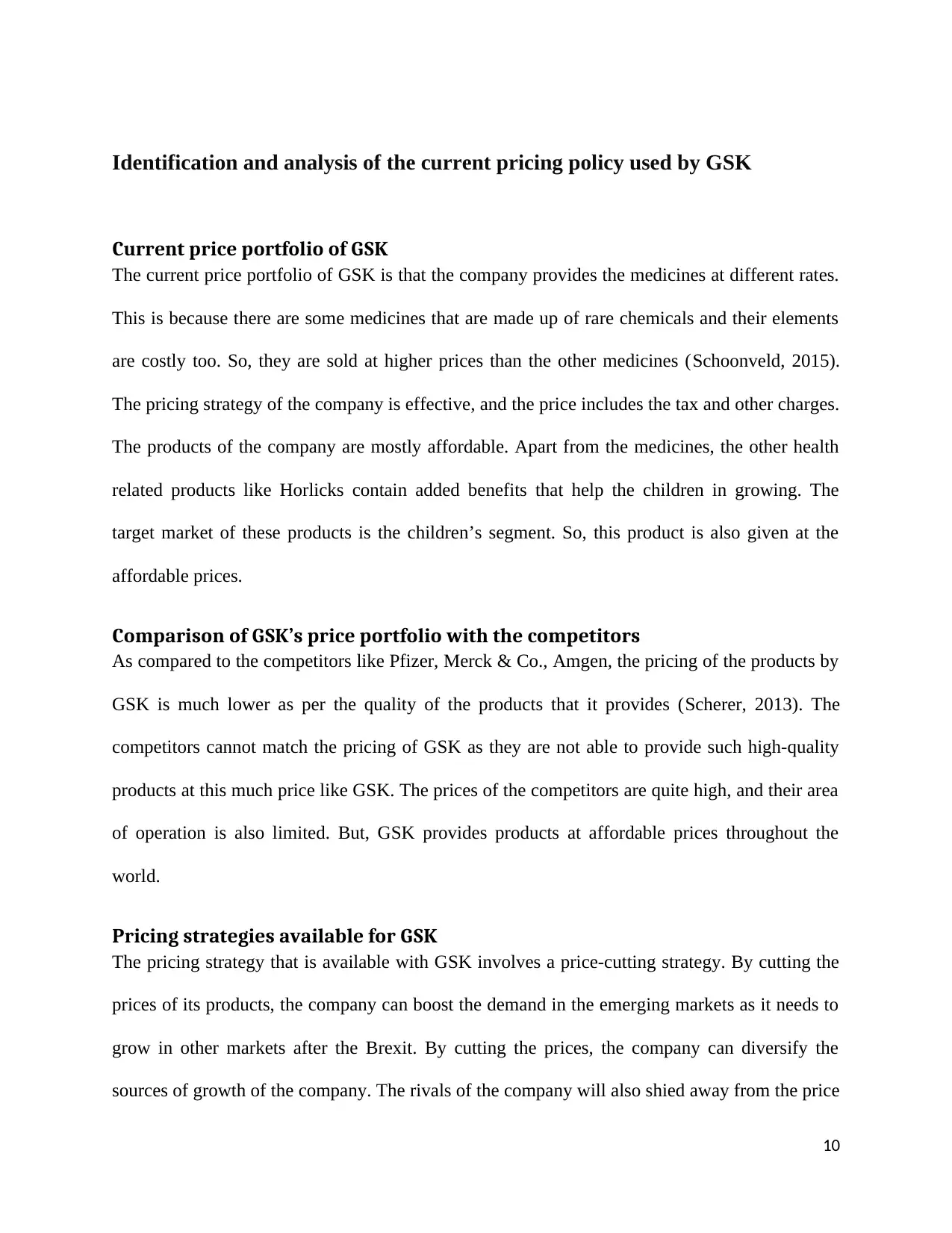
Identification and analysis of the current pricing policy used by GSK
Current price portfolio of GSK
The current price portfolio of GSK is that the company provides the medicines at different rates.
This is because there are some medicines that are made up of rare chemicals and their elements
are costly too. So, they are sold at higher prices than the other medicines (Schoonveld, 2015).
The pricing strategy of the company is effective, and the price includes the tax and other charges.
The products of the company are mostly affordable. Apart from the medicines, the other health
related products like Horlicks contain added benefits that help the children in growing. The
target market of these products is the children’s segment. So, this product is also given at the
affordable prices.
Comparison of GSK’s price portfolio with the competitors
As compared to the competitors like Pfizer, Merck & Co., Amgen, the pricing of the products by
GSK is much lower as per the quality of the products that it provides (Scherer, 2013). The
competitors cannot match the pricing of GSK as they are not able to provide such high-quality
products at this much price like GSK. The prices of the competitors are quite high, and their area
of operation is also limited. But, GSK provides products at affordable prices throughout the
world.
Pricing strategies available for GSK
The pricing strategy that is available with GSK involves a price-cutting strategy. By cutting the
prices of its products, the company can boost the demand in the emerging markets as it needs to
grow in other markets after the Brexit. By cutting the prices, the company can diversify the
sources of growth of the company. The rivals of the company will also shied away from the price
10
Current price portfolio of GSK
The current price portfolio of GSK is that the company provides the medicines at different rates.
This is because there are some medicines that are made up of rare chemicals and their elements
are costly too. So, they are sold at higher prices than the other medicines (Schoonveld, 2015).
The pricing strategy of the company is effective, and the price includes the tax and other charges.
The products of the company are mostly affordable. Apart from the medicines, the other health
related products like Horlicks contain added benefits that help the children in growing. The
target market of these products is the children’s segment. So, this product is also given at the
affordable prices.
Comparison of GSK’s price portfolio with the competitors
As compared to the competitors like Pfizer, Merck & Co., Amgen, the pricing of the products by
GSK is much lower as per the quality of the products that it provides (Scherer, 2013). The
competitors cannot match the pricing of GSK as they are not able to provide such high-quality
products at this much price like GSK. The prices of the competitors are quite high, and their area
of operation is also limited. But, GSK provides products at affordable prices throughout the
world.
Pricing strategies available for GSK
The pricing strategy that is available with GSK involves a price-cutting strategy. By cutting the
prices of its products, the company can boost the demand in the emerging markets as it needs to
grow in other markets after the Brexit. By cutting the prices, the company can diversify the
sources of growth of the company. The rivals of the company will also shied away from the price
10
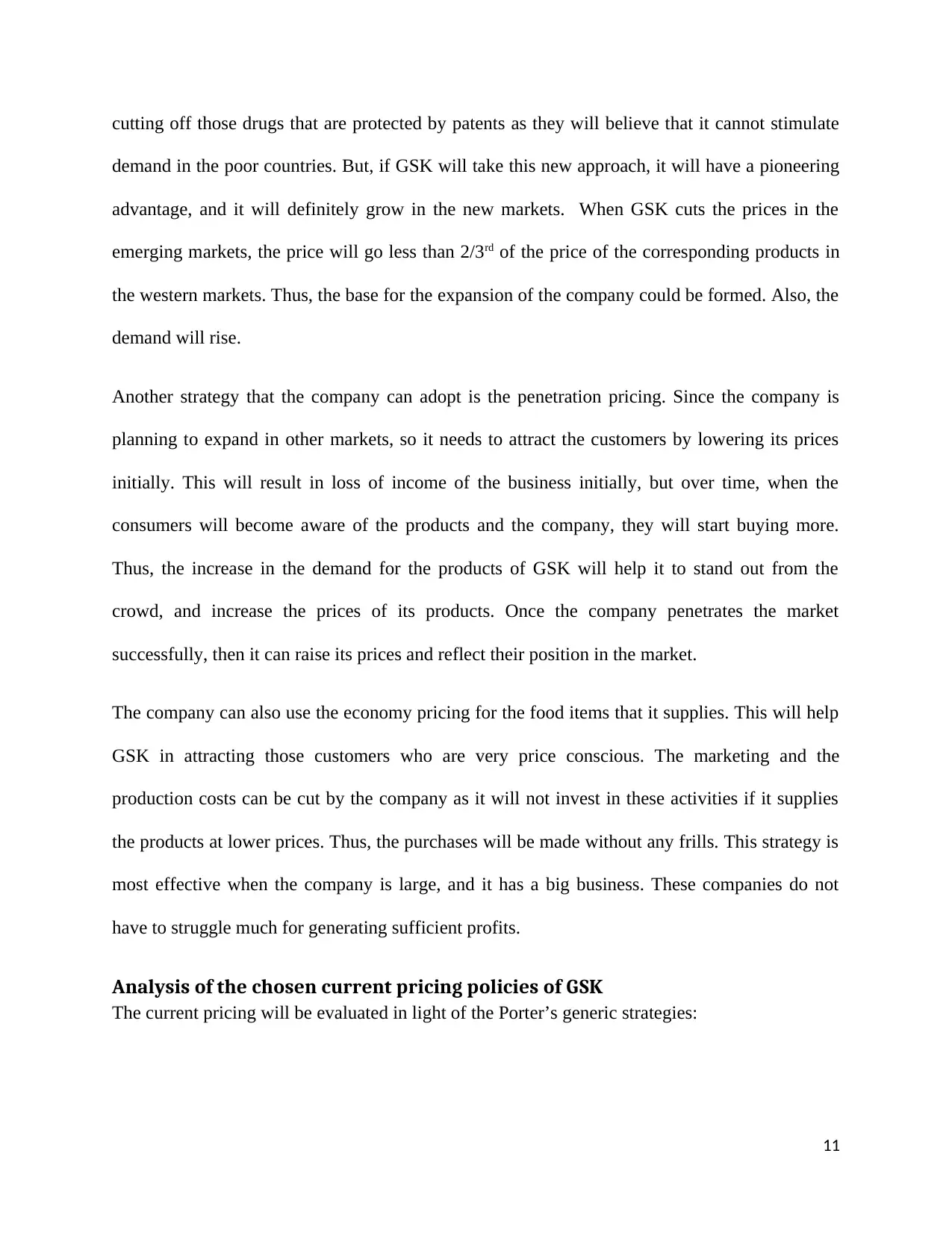
cutting off those drugs that are protected by patents as they will believe that it cannot stimulate
demand in the poor countries. But, if GSK will take this new approach, it will have a pioneering
advantage, and it will definitely grow in the new markets. When GSK cuts the prices in the
emerging markets, the price will go less than 2/3rd of the price of the corresponding products in
the western markets. Thus, the base for the expansion of the company could be formed. Also, the
demand will rise.
Another strategy that the company can adopt is the penetration pricing. Since the company is
planning to expand in other markets, so it needs to attract the customers by lowering its prices
initially. This will result in loss of income of the business initially, but over time, when the
consumers will become aware of the products and the company, they will start buying more.
Thus, the increase in the demand for the products of GSK will help it to stand out from the
crowd, and increase the prices of its products. Once the company penetrates the market
successfully, then it can raise its prices and reflect their position in the market.
The company can also use the economy pricing for the food items that it supplies. This will help
GSK in attracting those customers who are very price conscious. The marketing and the
production costs can be cut by the company as it will not invest in these activities if it supplies
the products at lower prices. Thus, the purchases will be made without any frills. This strategy is
most effective when the company is large, and it has a big business. These companies do not
have to struggle much for generating sufficient profits.
Analysis of the chosen current pricing policies of GSK
The current pricing will be evaluated in light of the Porter’s generic strategies:
11
demand in the poor countries. But, if GSK will take this new approach, it will have a pioneering
advantage, and it will definitely grow in the new markets. When GSK cuts the prices in the
emerging markets, the price will go less than 2/3rd of the price of the corresponding products in
the western markets. Thus, the base for the expansion of the company could be formed. Also, the
demand will rise.
Another strategy that the company can adopt is the penetration pricing. Since the company is
planning to expand in other markets, so it needs to attract the customers by lowering its prices
initially. This will result in loss of income of the business initially, but over time, when the
consumers will become aware of the products and the company, they will start buying more.
Thus, the increase in the demand for the products of GSK will help it to stand out from the
crowd, and increase the prices of its products. Once the company penetrates the market
successfully, then it can raise its prices and reflect their position in the market.
The company can also use the economy pricing for the food items that it supplies. This will help
GSK in attracting those customers who are very price conscious. The marketing and the
production costs can be cut by the company as it will not invest in these activities if it supplies
the products at lower prices. Thus, the purchases will be made without any frills. This strategy is
most effective when the company is large, and it has a big business. These companies do not
have to struggle much for generating sufficient profits.
Analysis of the chosen current pricing policies of GSK
The current pricing will be evaluated in light of the Porter’s generic strategies:
11
⊘ This is a preview!⊘
Do you want full access?
Subscribe today to unlock all pages.

Trusted by 1+ million students worldwide
1 out of 17
Related Documents
Your All-in-One AI-Powered Toolkit for Academic Success.
+13062052269
info@desklib.com
Available 24*7 on WhatsApp / Email
![[object Object]](/_next/static/media/star-bottom.7253800d.svg)
Unlock your academic potential
Copyright © 2020–2025 A2Z Services. All Rights Reserved. Developed and managed by ZUCOL.





